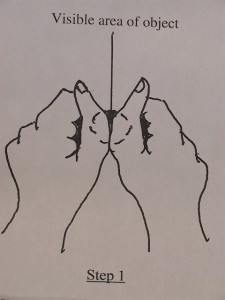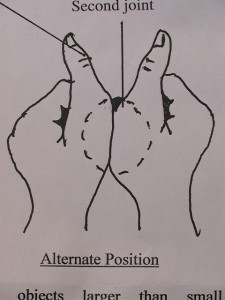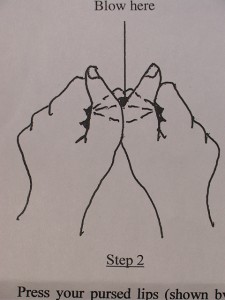Last night I attended the Full Moon Drum Circle at the Dandelion Cafe in Orlando, Fl. This small circle is generous; the participants always bring a variety of acoustic instruments for self and group expression. And it’s not an instrument’s fault if a discordant note is occasionally heard. The most pleasing key at this circle, at least to my ears, is B. Continue reading “once in a blue blue moon”
Blog
thumbouchure
Acorn caps can be used as whistles, if you know how to do it. In North America both thumbs are used. In Europe, only the index and middle finger of one hand are used. No one knows when or where this arcane and obscure skill originated or why there are two different styles of whistling with acorn caps.
I am thankful that I learned the North American style first because once I applied the skill to small seashells my fingers were free to wrap around shell bodies. I drilled pitch holes into logarithmic spiral shells, under where my finger tips touched the shell whorls and found the musical scales, but that’s another story told elsewhere throughout this blog.
I call the ‘acorn cap whistle skill’ thumbouchure. It is the way both thumbs are used to cover and seal the opening of a shell or other concave object to make sound.
There are two North American thumbouchure positions. The size of the object or shell instrument opening (aperture) relative to the width of the players thumbs determines which position will be used. The first (standard) thumbouchure position is used with small shell openings (1/4″ – 2″ wide) and is made as follows:
make two fists with thumbs on top. Bring both fists evenly together so that the thumb joints of each hand are pressed evenly together. With thumbs still touching separate both fists a few inches apart, like your thumbs are hinged. You will now be looking at the back of each fist. Push thumbnails evenly apart to form a wedge shaped opening above the thumb joints. This wedged shaped opening is called the wind way. Thumbs stay pressed together below the wind way.
The second position is used with larger shell openings (2″ – 4″) and is made as follows: same as standard thumbouchure position except separate the thumbs at the second joints to create the wind way. An alternate way to do this that allows the fingers of the right hand to more easily touch the shell body is to press the right thumb joint against the left thumb knuckle (second thumb joint) The meaty part of the left thumb will be used to cover and seal three quarters of larger shell openings. The right thumb will cover the remaining area of the opening and make the wind way.
Once the shell or concave object has been positioned under the thumbs using the first or second thumbouchure positions it is time to place the lips on the thumbs and blow breath through the wind way.
The wind way is the area at the bottom of the wedged shaped opening created by the parted thumbs. Keeps your lips soft and shaped like you’re saying the word ‘who’. Press both lips onto your thumbs so that the breath exits the mouth only from under the upper lip. The bottom lip is pressed onto the thumbs a bit below the wind way.The breath strikes the exposed rim of the object and resonates the air inside the object.
The smaller the object the faster the breath needs to be. Puff the cheeks out and blow forcefully when using small objects such as acorn caps, bottle tops, small clam shells or other small shells, thimbles or hard uncooked seashell pasta. Blow gently for larger objects. Make adjustments until you hear sound. Thumbouchure creates rim blown whistles out of many manufactured and naturally occurring objects. Have fun. Enjoy!
Mother of Music
Most small and empty univalve seashells encase spiral columns of air space that can be resonated to produce sound. The shell, Terebra Turritella, commonly known as the Screw Shell or Unicorn Shell, encases a conical helix air space. Experts report that Its shape has remained the same since the Jurassic Period.
The first eight whorls, counting from the shell opening (aperture) to the pointy end (apex), are hollow. After that the whorls are solid to the shell apex. A whorl is one revolution of the spiral. If one draws a lengthwise center line on the shell, one spiral revolution begins on the line and ends on the adjacent whorl line, either above or below the starting point.
The air space inside one spiral revolution of the Terebra Turritella shell increases or decreases in volume logarithmically. Diatonic musical notes also increase or decrease in pitch logarithmically. In the case of the Terebra Turritella shell the spiral logarithmic air space contains the logarithmic diatonic musical scale potential. Another way of saying that is the diatonic musical scale is dormant within the first eight whorls of theTerebra Turritella shell.
The Terebra Turritella shell releases the diatonic musical scale of notes when five pitch holes are drilled into whorls 2, 3, 4, 6 and 8, following the lengthwise axis line of the shell. The logarithmic shape of the shell’s air space corresponds to and contains the diatonic scale of notes. In fact, an octave and a half of diatonic and chromatic notes are available.
No mathematical measurements or calculations are required or necessary to create this musical instrument. All other musical instruments in the world, capable of releasing the pentatonic, diatonic and chromatic scales of notes, require the use of mathematical calculations or measurements in their construction.
The Turritella Shell Flute is a primal and natural musical instrument. I consider it to be the Mother of Music and Musical Instruments. It’s spiral shape, along with the five pitch holes, releases an octave and a half of pentatonic, diatonic and chromatic notes. The shell contains all the mathematical calculations required to make this happen. Why a snail created this shell shape is a matter of conjecture.
Seashells and Music; a Poem and Song
Conch by E B White:
Hold a baby to your ear
As you would a shell:
Sounds of centuries you will hear
New Centuries foretell.
Who can break a baby’s code?
And which is the older-
The listener or his small load?
The held or the holder?
Last week I made a lot of seashell spiral flutes. All but a few played diatonic musical scales. Those few were somehow misshapen – they were elongated more than normal Terebra Turritella shells. I assume something in the environment caused this.
To the eye, these elongated shells are still pleasing to look at. But to the ear; they are not pleasing at all. When the five pitch holes are drilled through the shell they produce an ‘out of tune’ scale of notes.
A normal Terebra Turritella shell will produce pentatonic, diatonic and chromatic scales of notes when five pitch holes are drilled through whorls number 2, 3, 4, 6 and 8. The two half steps of the diatonic scale are in whorls 2 and 6. In fact, each of the five pitch holes produce sharps, flats and micro tones, giving the player the ability to play the chromatic scale of notes. Slight variations in the force of the breath make this possible.
The shape of the tube has everything to do with the range and sensitivity of the instrument. As it is the first conical helix shaped flute ever made nothing is known about it, scientifically, except what Rollins College Physics Dept has discovered, and they haven’t published their findings yet. (They’ve been studying the instrument for over five years.). More research needs to be done to explain why this instrument works.
A couple of years ago I recorded ‘Somewhere Over the Rainbow’ in a professional sound studio on a seashell flute in the key of B. The sound engineer added a reverb effect to the recording. He said it made it sound better. I’ve practiced more since then and can probably do better now.
The next time I record seashell flute music I’d like to be accompanied by other instruments. I’ve played with Native American Flute musicians. The two different types of flutes sound good together. I’ve also played with a steel drum musician at a farmer’s market I vend at. Again, the instruments sound good together.
Festivals
Last year brought two new experiences my way: I was asked to play my seashell flute over a PA system at the New Smyrna Beach Farmer’s Market during the Christmas season. The Beau Sister’s were singing Christmas songs and during one of their breaks I played ‘Greensleeves’. I remember being a little nervous but it sounded good and people seemed to like it.
I usually can’t get away from my vending booth long enough to play tunes with the hired musicians because I don’t have any help. So I just play along with them from a distance. I find it’s a good way to advertise my wares. People hear me and are attracted to the sounds. They’re curious and want to find out what’s making that soft flute music.
I’ve gotten a lot of practice over the years playing my seashell flutes along with different musicians at the markets. That’s one of the main benefits farmer’s markets have given me. Lot’s of practice. It’s how I’ve become a Shellist. Practice. I tell everyone that the seashell flute is not an easy instrument to play. It’s just like any other instrument. You have to practice a lot to sound any good.
The first time I played in front of an audience using a PA system was at the Silverhawk Native American Flute Festival last year. That was also my first NAF event and I feel I will always remember it as the best. You know how that goes. Anyway, the MC at the event announced that it was open mic and anyone who wanted to could come up and play a tune. I played Amazing Grace and something Celtic sounding.
This spring I am scheduled to vend at four or five music festivals. I’m excited to be able to play along with many excellent quality musicians, from a distance, of course. A few of the festivals are NAF events. I really like the sound of NAFs and the quality of the music. It’s a soothing and soulful style of flute music.
I will be vending at the 60th Florida Folk Festival this Memorial Day weekend and expect it to be my biggest event. It certainly is an honor to be part of that great musical tradition. I have been asked to be a ‘demonstrator’ also. I think that means showing folks how I make the instruments, talk about how I discovered them and perform a few tunes, away from my booth. I sure hope my sister, Betsy, is able to help me vend.

